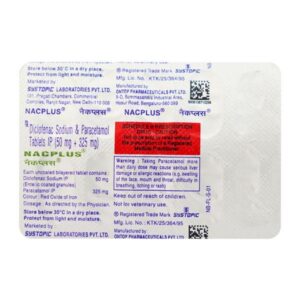DICLOFENAC + PARACETAMOL
Diclofenac: Diclofenac is a medication classified as a nonsteroidal anti-inflammatory drug (NSAID). It is commonly used to relieve pain, reduce inflammation, and alleviate fever.
The drug works by inhibiting the production of substances in the body called prostaglandins. Prostaglandins play a role in causing pain, inflammation, and fever, so by reducing their production, diclofenac helps to alleviate these symptoms.
Diclofenac is available in several forms, including tablets, capsules, topical gels, patches, and injections. The recommended dose and administration method may vary depending on the condition being treated and the form of the medication. It is crucial to follow the instructions provided by healthcare professionals or provided on the product label.
As with any medication, diclofenac may cause side effects. Common side effects include gastrointestinal issues such as stomach pain, indigestion, nausea, and diarrhea. Additionally, some people may experience dizziness, headache, rash, itching, or swelling. In rare cases, diclofenac can cause more severe side effects such as liver or kidney problems, high blood pressure, heart issues, or allergic reactions. It is advised to seek medical attention if any severe side effects occur.
Diclofenac may interact with other medications, so it is essential to inform your healthcare provider about any other drugs you are taking. It should be used with caution in individuals with a history of ulcers, bleeding disorders, or asthma. Diclofenac is not recommended during pregnancy, especially during the third trimester, as it can cause harm to the unborn baby.
Overall, diclofenac is a widely used NSAID medication that effectively helps to relieve pain, inflammation, and fever. However, it is essential to use it under medical supervision, follow the recommended dose, and be aware of potential side effects and interactions.
Paracetamol: Paracetamol, also known as acetaminophen, is a widely used over-the-counter medication primarily used to relieve pain and reduce fever. It belongs to the family of analgesics (pain relievers) and antipyretics (fever reducers).
Paracetamol works by inhibiting the production of prostaglandins, chemicals in the body that contribute to pain and fever. It primarily acts on the central nervous system to provide pain relief but also acts on the hypothalamus to lower fever.
The recommended dose of paracetamol for adults is usually 500 to 1000 mg every 4 to 6 hours, with a maximum daily dose of 4000 mg. However, the specific dosage may vary depending on the country and the individual’s condition. It is important to follow the instructions provided by the healthcare professional or read the package insert.
Paracetamol is available in various forms, including tablets, capsules, oral suspension, and suppositories. It is commonly used to treat mild to moderate pain such as headache, toothache, muscle aches, and menstrual cramps. It is also utilized to reduce fever associated with colds, flu, and other infections.
While paracetamol is generally considered safe when used as directed, it may have some side effects. Common side effects include nausea, vomiting, and stomach pain, although these are usually mild and temporary. Allergic reactions are rare but possible, and they may manifest as skin rash, itching, swelling, or difficulty breathing. In rare cases, paracetamol can cause liver damage if taken in excessive doses or in combination with alcohol or certain medications. It is essential to avoid exceeding the recommended dose and to seek medical attention if any concerning side effects occur.
It is important to note that this description provides a general overview of paracetamol, and it is recommended to consult a healthcare professional or refer to the package label for specific instructions and information related to your individual circumstances.

